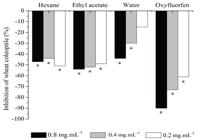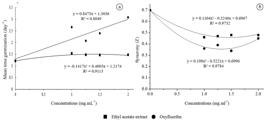Abstract
The loss of leaves by plant species found in the Cerrado (Brazilian savanna) is an energetically expensive process due to adverse environmental conditions and predation by herbivory. The mature leaves have adaptations which minimize these events. However, the young individuals lack these structures and produce high leaf concentrations of secondary metabolites as a form of protection. These compounds can be used in bioprospection of natural herbicides. Thus, this study aimed to evaluate the phytotoxicity of hexane, ethyl acetate and aqueous extracts of young leaves from Blepharocalyx salicifolius (Kunth) O. Berg on the elongation of wheat coleoptiles (Triticum aestivum L.) and evaluate the potential phytotoxic of ethyl acetate extract on germination, growth and cell size of metaxylem of sesame (Sesamum indicum L.) seedlings. The hexane and ethyl acetate extracts inhibited the elongation of wheat coleoptiles at all concentrations; however, the most promising results were observed in coleoptile fragments treated with the ethyl acetate extract. This treatment changed the mean germination time and the synchrony of sesame seeds, inhibited the growth of shoots and roots, reduced the dry weight of seedlings, led to abnormalities in the seedlings and reduced the length of the metaxylem cells in the sesame seedlings. These results demonstrated the phytotoxic potential of young leaf extracts of B. salicifolius and the high phytotoxicity of the ethyl acetate extract in the initial development of S. indicum.
Keywords:
Triticum aestivum; Sesamum indicum; murta; allelopathy; bioactivity

 Thumbnail
Thumbnail
 Thumbnail
Thumbnail
 Thumbnail
Thumbnail
 Thumbnail
Thumbnail
 Thumbnail
Thumbnail
 Thumbnail
Thumbnail





